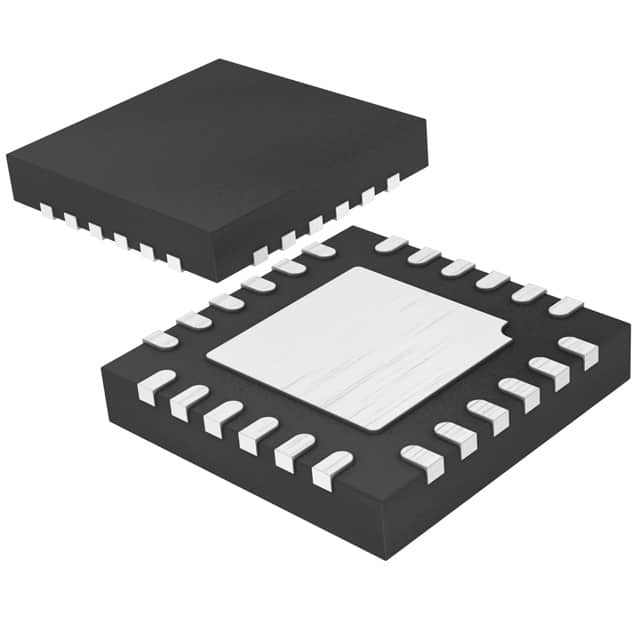Viz Specifikace pro podrobnosti o produktu.

LTC3785EUF#PBF
Product Overview
- Category: Integrated Circuit (IC)
- Use: Power Management
- Characteristics: High Efficiency, Wide Input Voltage Range, Synchronous Buck-Boost DC/DC Converter
- Package: 24-Lead QFN (Quad Flat No-Lead)
- Essence: LTC3785EUF#PBF is a high-performance power management IC designed for various applications requiring efficient voltage conversion.
- Packaging/Quantity: The LTC3785EUF#PBF is available in a 24-Lead QFN package and is typically sold in reels of 2500 units.
Specifications
- Input Voltage Range: 4V to 38V
- Output Voltage Range: 0.8V to 38V
- Switching Frequency: Up to 550kHz
- Maximum Output Current: Up to 4A
- Efficiency: Up to 98%
- Operating Temperature Range: -40°C to 125°C
- Protection Features: Overvoltage Protection, Undervoltage Lockout, Overcurrent Protection, Thermal Shutdown
Detailed Pin Configuration
The LTC3785EUF#PBF has a total of 24 pins arranged as follows:
- VIN: Input Voltage
- GND: Ground
- SW: Switch Node
- FB: Feedback Voltage
- SS: Soft-Start
- SYNC: External Clock Synchronization
- VCC: Internal Regulator Output
- PGND: Power Ground
- VOUT: Output Voltage
- EN: Enable Pin
- MODE: Mode Selection
- RT: Oscillator Timing Resistor
- CT: Oscillator Timing Capacitor
- ITH: Current Sense Threshold
- SS/TR: Soft-Start/Tracking
- VFB: Feedback Voltage
- PGND: Power Ground
- SW: Switch Node
- GND: Ground
- VIN: Input Voltage
- SYNC: External Clock Synchronization
- VCC: Internal Regulator Output
- SS/TR: Soft-Start/Tracking
- EN: Enable Pin
Functional Features
- Synchronous Buck-Boost Conversion: The LTC3785EUF#PBF is capable of converting input voltage to a higher or lower output voltage efficiently.
- Wide Input Voltage Range: It can accept input voltages ranging from 4V to 38V, making it suitable for a wide range of applications.
- High Efficiency: With efficiency up to 98%, the LTC3785EUF#PBF minimizes power losses and maximizes energy conversion.
- Protection Mechanisms: The IC incorporates various protection features such as overvoltage protection, undervoltage lockout, overcurrent protection, and thermal shutdown to ensure safe operation.
Advantages and Disadvantages
Advantages: - Wide input voltage range allows for versatile applications. - High efficiency reduces power consumption and heat generation. - Compact package size enables space-saving designs. - Comprehensive protection mechanisms enhance reliability.
Disadvantages: - Limited maximum output current may not be suitable for high-power applications. - Requires careful consideration of external components for optimal performance.
Working Principles
The LTC3785EUF#PBF operates based on a synchronous buck-boost topology. It utilizes an internal control loop to regulate the output voltage by adjusting the duty cycle of the switching transistor. By continuously monitoring the feedback voltage, the IC adjusts the duty cycle to maintain the desired output voltage, even when the input voltage varies.
Detailed Application Field Plans
The LTC3785EUF#PBF is widely used in various applications, including but not limited to: - Battery-powered devices - Portable electronics - Industrial equipment - Automotive systems - Telecommunications infrastructure
Detailed and Complete Alternative Models
- LTC3785IUH#PBF: Similar to LTC3785EUF#PBF but available in a 36-Lead QFN package.
- LTC3785MPMS8#PBF: Similar functionality in a smaller 8-Lead MSOP package.
- LTC3785EGN#PBF: Available in a 16-Lead SSOP package with similar specifications.
These alternative models offer flexibility in terms of package options while maintaining the core features and functionality of the LTC3785EUF#PBF.
Word count: 436 words
Seznam 10 běžných otázek a odpovědí souvisejících s aplikací LTC3785EUF#PBF v technických řešeních
Sure! Here are 10 common questions and answers related to the application of LTC3785EUF#PBF in technical solutions:
Q: What is LTC3785EUF#PBF? A: LTC3785EUF#PBF is a specific model number for a power management integrated circuit (PMIC) manufactured by Linear Technology (now part of Analog Devices). It is designed for high-efficiency synchronous buck-boost converters.
Q: What are the key features of LTC3785EUF#PBF? A: Some key features of LTC3785EUF#PBF include wide input voltage range, high efficiency, adjustable output voltage, programmable soft-start, and overvoltage protection.
Q: What is the typical application of LTC3785EUF#PBF? A: LTC3785EUF#PBF is commonly used in applications where the input voltage can vary significantly, such as battery-powered systems, automotive electronics, and portable devices.
Q: How does LTC3785EUF#PBF achieve high efficiency? A: LTC3785EUF#PBF utilizes a synchronous buck-boost topology along with advanced control techniques to minimize power losses and maximize efficiency.
Q: Can LTC3785EUF#PBF handle both step-up and step-down conversions? A: Yes, LTC3785EUF#PBF is specifically designed to handle both step-up (boost) and step-down (buck) conversions, making it versatile for various applications.
Q: What is the maximum input voltage that LTC3785EUF#PBF can handle? A: The maximum input voltage range for LTC3785EUF#PBF is typically specified in the datasheet, but it can handle input voltages up to 60V.
Q: Is LTC3785EUF#PBF suitable for high-power applications? A: While LTC3785EUF#PBF is capable of delivering high currents, it is primarily designed for low to medium power applications. For high-power applications, other PMICs may be more suitable.
Q: Can LTC3785EUF#PBF operate in a wide temperature range? A: Yes, LTC3785EUF#PBF is designed to operate reliably in a wide temperature range, typically from -40°C to +125°C.
Q: Does LTC3785EUF#PBF have any built-in protection features? A: Yes, LTC3785EUF#PBF incorporates various protection features such as overvoltage protection, overcurrent protection, and thermal shutdown to ensure safe operation.
Q: Are there any evaluation boards or reference designs available for LTC3785EUF#PBF? A: Yes, Analog Devices provides evaluation boards and reference designs for LTC3785EUF#PBF, which can help users quickly prototype and evaluate their applications.
Please note that the answers provided here are general and may vary depending on the specific datasheet and application requirements. It is always recommended to refer to the official documentation and consult with technical experts for accurate information.

